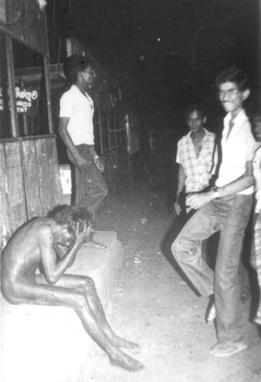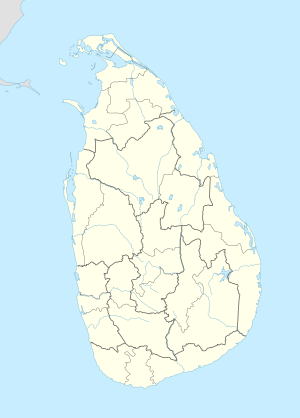
Mawanella is a town which belongs to the Kegalle district in the Sabaragamuwa Province of Sri Lanka. It lies between Kegalle and Kadugannawa along the Colombo-Kandy road. The area consists of four administrative areas, namely Mawanella, Aranayake, Rambukkana and Hemmathagama.
Freedom of religion in Sri Lanka is a protected right under Chapter II, Article 9 of the constitution of Sri Lanka. This applies to all religions, though Buddhism is given the foremost place under the 1978 Republican Constitution. Sri Lanka is regarded by its Supreme Court as being a secular state.

Black July was an anti-Tamil pogrom that occurred in Sri Lanka during July 1983. The pogrom was premeditated, and was finally triggered by a deadly ambush on 23 July 1983, which caused the death of 13 Sri Lanka Army soldiers, by the Tamil militant group Liberation Tigers of Tamil Eelam (LTTE). Although initially orchestrated by members of the ruling UNP, the pogrom soon escalated into mass violence with significant public participation.
Human rights in Sri Lanka provides for fundamental rights in the country. The Sri Lanka Constitution states that every person is entitled to freedom of thought, conscience and religion, including the freedom to have or to adopt a religion or belief of his choice. And, that every person is equal before the law.

The 1958 anti-Tamil pogrom and riots in Ceylon, also known as the 58 riots, refer to the first island-wide ethnic riots and pogrom to target the minority Tamils in the Dominion of Ceylon after it became an independent dominion from Britain in 1948. The riots lasted from 22 May until 29 May 1958 although sporadic disturbances happened even after the declaration of emergency on 27 May 1958. The estimates of the murders range, based on recovered bodies, from 158 to 1,500. Although most of the victims were Tamils, Sinhalese and their property were also affected by retaliatory attacks by Tamil mobs throughout the Batticaloa and Jaffna districts. As the first full-scale race riot in the country in over forty years, the events of 1958 shattered the trust the communities had in one another and led to further polarisation.

The 1977 anti-Tamil pogrom in Sri Lanka followed the 1977 general elections in Sri Lanka where the Sri Lankan Tamil nationalistic Tamil United Liberation Front won a plurality of minority Sri Lankan Tamil votes. In the elections, the party stood for secession. An official government estimate put the death toll at 125, whereas other sources estimate that around 300 Tamils were killed by Sinhalese mobs. Human rights groups, such as the UTHR-J, accused the newly elected UNP-led government of orchestrating the violence.
The Colombo central bus station bombing was the car bombing of the central bus terminal of Colombo carried out on April 21, 1987, in Pettah, Colombo, Sri Lanka. The 80-pound (36 kg) bomb killed at least 113 people and left a 10-foot (3 m) crater in the ground. The New York Times estimated 200 people had been injured.

The 1956 anti-Tamil pogrom, also known as the Gal Oya riots, was the first organised pogrom against Sri Lankan Tamils in the Dominion of Ceylon. It began with anti-Tamil rioting in Colombo, followed by anti-Sinhalese rioting in Batticaloa. The worst of the violence took place in the Gal Oya valley, where local majority Sinhalese colonists and employees of the Gal Oya Development Board commandeered government vehicles, dynamite and weapons and massacred minority Tamils. It is estimated that over 150 people, mostly Tamils, had died during the violence. The police and army were eventually able to bring the situation under control.
A mass murder of Sri Lankan Police officers took place on 11 June 1990. Members of the Liberation Tigers of Tamil Eelam (LTTE), a militant organization, are alleged to have killed over 600 unarmed Sri Lanka Police officers in Eastern Province, Sri Lanka. Some accounts have estimated the number killed as high as 774. It was the deadliest terrorist incident in the world at the time until the September 11 attacks occurred in 2001.

Bodu Bala Sena, also abbreviated as BBS is a far-right anti-liberalist, and ultranationalist Sinhalese Buddhist organization, and a break-away faction from the right-wing nationalist Jathika Hela Urumaya party. The BBS generally opposes pluralist and democratic ideologies, and criticizes non-extremist Buddhist monks for not taking action against the rise of other religions within Sri Lanka.
The 1915 Sinhalese-Muslim riots was a widespread and prolonged ethnic riot in the island of Ceylon between Sinhalese Buddhists and the Ceylon Moors. The riots were eventually suppressed by the British colonial authorities.

Dharga Town is a town located in Kalutara District, Western Province, Sri Lanka. It is governed by the Beruwala Urban Council under the Government of Sri Lanka, and is close to Aluthgama and the tourist town Bentota.
The 2014 anti-Muslim riots in Sri Lanka were religious and ethnic riots in June 2014 in south-western Sri Lanka. Muslims and their property were attacked by Sinhalese Buddhists in the towns of Aluthgama, Beruwala and Dharga Town in Kalutara District. At least four people were killed and 80 injured. Hundreds were made homeless following attacks on homes, shops, factories, mosques and a nursery. 10,000 people were displaced by the riots. The riots followed rallies by Bodu Bala Sena (BBS), a hard line Buddhist group. The BBS was widely blamed for inciting the riots but it has denied responsibility. The mainstream media in Sri Lanka censored news about the riots following orders from the Sri Lankan government.
The following lists events that happened during 1983 in Sri Lanka.
The Sri Lankan anti-Muslim riots were a series of religious riots targeting Muslims that began in the town of Ampara located in Sri Lanka on 26 February 2018, spreading to the Kandy District from March 2 until its end on March 10, 2018.
The Sri Lankan anti-Muslim riots were a series of religiously motivated riots targeting Muslims in Sri Lanka. The riots originated as isolated incidents in the aftermath of the Easter bombings in the nation, beginning in Chilaw and subsequently spreading to much of the Northwestern Province.

The 2022 Sri Lankan protests, commonly known as Aragalaya, were a series of mass protests that began in March 2022 against the government of Sri Lanka. The government was heavily criticized for mismanaging the Sri Lankan economy, which led to a subsequent economic crisis involving severe inflation, daily blackouts, and a shortage of fuel, domestic gas, and other essential goods. The protesters' main demand was the resignation of President Gotabaya Rajapaksa and key officials from the Rajapaksa family. Despite the involvement of several opposition parties, most protesters considered themselves to be apolitical, with many expressing discontent with the parliamentary opposition. Protesters chanted slogans such as "Go Home Gota", "Go Home Rajapaksas", and "Aragalayata Jaya Wewa". Most protests were organized by the general public, with youths playing a major part by carrying out protests at Galle Face Green.

2006 anti-Tamil riots in Trincomalee were a series of organized violence against the Tamil population of the Trincomalee town and its outskirts in eastern Sri Lanka that followed a bomb blast on 12 April 2006. The violence was mainly carried out by Sinhalese mobs, Navy personnel and home guards with the overall complicity of the Sri Lankan security forces and police. By 20 April, the violence had left over 20 civilians dead, 75 injured, over 30 shops and 100 houses burned, and over 3,000 people displaced.







